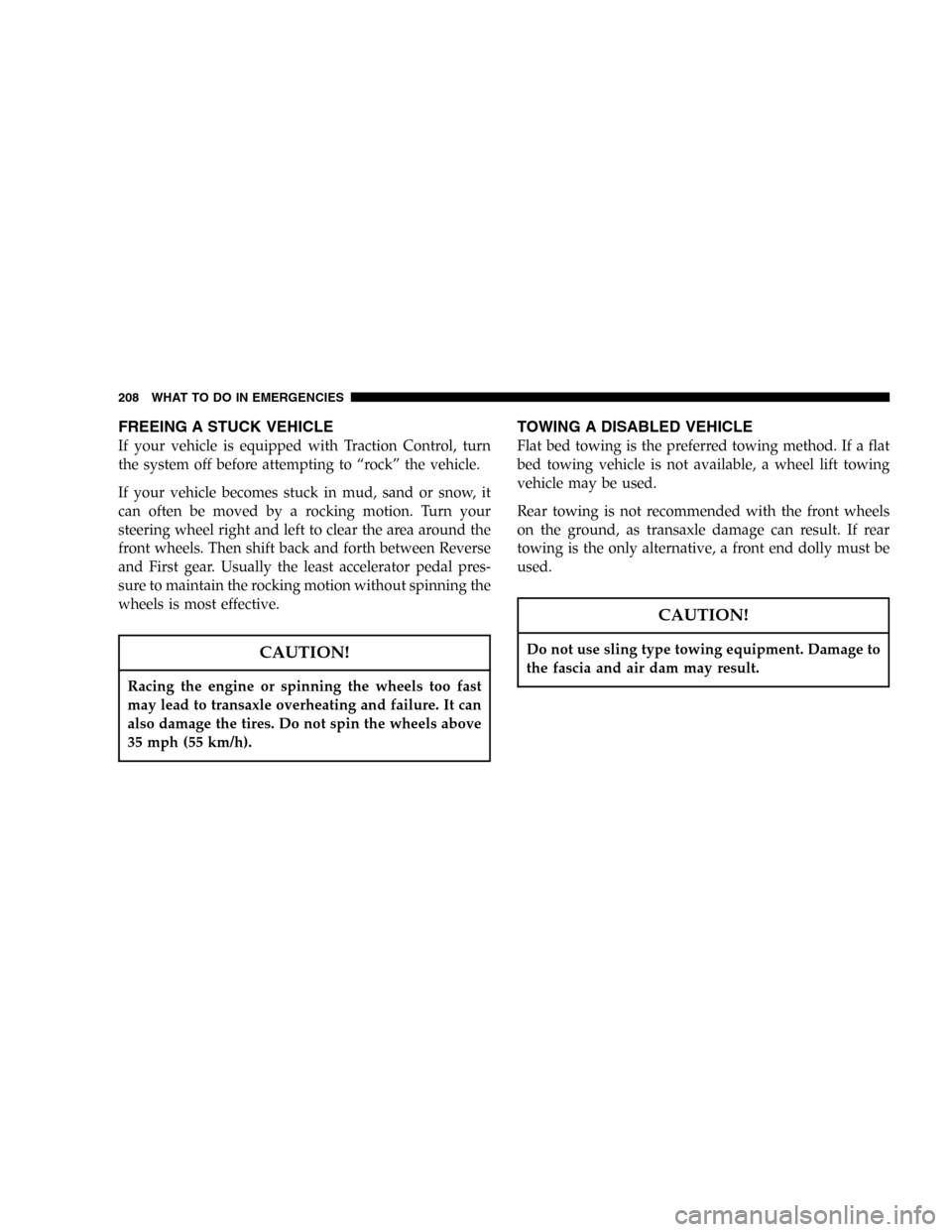Page 205 of 302

WARNING!
Do not permit vehicles to touch each other as this
could establish a ground connection and person
injury could result.
5. Connect the other cable, first to the negative terminal
of the booster battery and then to the jump start attach-
ment of the vehicle with the discharged battery. Make
sure you have a good contact on the engine.
WARNING!
Do not connect the cable to the negative post of the
discharged battery. The resulting electrical spark
could cause the battery to explode.
During cold weather when temperatures are below
freezing point, electrolyte in a discharged battery
may freeze. Do not attempt jump starting because
the battery could rupture or explode. The battery
temperature must be brought up above freezing
point before attempting to jump start.
6. Start the engine in the vehicle that has the booster
battery, let the engine idle a few minutes, then start the
engine in the vehicle with the discharged battery.Jump Starting
WHAT TO DO IN EMERGENCIES 205
6
Page 207 of 302

DRIVING ON SLIPPERY SURFACES
Acceleration
Rapid acceleration on snow covered, wet, or other slip-
pery surfaces may cause the front wheels to pull errati-
cally to the right or left. This phenomenon occurs when
there is a difference in the surface traction under the front
(driving) wheels, particularly with high output engines.
WARNING!
Rapid acceleration on slippery surfaces is danger-
ous. Unequal traction can cause sudden pulling of
the front wheels. You could lose control of the
vehicle and possibly have an accident. Accelerate
slowly and carefully whenever there is likely to be
poor traction (ice, snow, wet, mud, loose sand, etc.).
Traction
When driving on wet or slushy roads, it is possible for a
wedge of water to build up between the tire and road
surface. This is hydroplaning and may cause partial or
complete loss of vehicle control and stopping ability. To
reduce this possibility, the following precautions should
be observed:
1. Slow down during rainstorms or when roads are
slushy.
2. Slow down if road has standing water or puddles.
3. Replace tires when tread wear indicators first become
visible.
4. Keep tires properly inflated.
5. Maintain enough distance between your vehicle and
the vehicle in front of you to avoid a collision in a sudden
stop.
NOTE:If so equipped, turn on the Traction Control
System to accelerate on slippery surfaces.
WHAT TO DO IN EMERGENCIES 207
6
Page 208 of 302

FREEING A STUCK VEHICLE
If your vehicle is equipped with Traction Control, turn
the system off before attempting to “rock” the vehicle.
If your vehicle becomes stuck in mud, sand or snow, it
can often be moved by a rocking motion. Turn your
steering wheel right and left to clear the area around the
front wheels. Then shift back and forth between Reverse
and First gear. Usually the least accelerator pedal pres-
sure to maintain the rocking motion without spinning the
wheels is most effective.
CAUTION!
Racing the engine or spinning the wheels too fast
may lead to transaxle overheating and failure. It can
also damage the tires. Do not spin the wheels above
35 mph (55 km/h).
TOWING A DISABLED VEHICLE
Flat bed towing is the preferred towing method. If a flat
bed towing vehicle is not available, a wheel lift towing
vehicle may be used.
Rear towing is not recommended with the front wheels
on the ground, as transaxle damage can result. If rear
towing is the only alternative, a front end dolly must be
used.
CAUTION!
Do not use sling type towing equipment. Damage to
the fascia and air dam may result.
208 WHAT TO DO IN EMERGENCIES
Page 211 of 302

MAINTAINING YOUR VEHICLE
CONTENTS
�2.4L Engine..........................213
�2.7L Engine..........................214
�Onboard Diagnostic System — OBD II......215
�Emissions Inspection And Maintenance
Programs
............................216
�Replacement Parts.....................217
�Dealer Service........................217
�Maintenance Procedures.................218
▫Engine Oil..........................218
▫Crankcase Emission Control System........224
▫Maintenance-Free Battery................225
▫Air Conditioner......................226▫Power Steering — Fluid Check............227
▫Suspension Ball Joints..................228
▫Body Mechanism Lubrication.............228
▫Windshield Wiper Blades................229
▫Windshield Washers...................230
▫Exhaust System......................231
▫Cooling System.......................232
▫Hoses And Vacuum/Vapor Harnesses.......236
▫Brakes.............................236
▫Fuel System Hoses....................239
▫Automatic Transmission................239
7
Page 212 of 302

▫Appearance Care And Protection From
Corrosion...........................241
�Convertible Top Care...................246
▫Washing............................246
▫General Cleaning.....................246
▫Cloth Top Additional Cleaning Procedure....247
▫Cloth Top Protection...................247
▫Weather Strip Care....................247
�Fuses...............................248
▫Underhood Fuses
(Power Distribution Center)..............248
▫Interior Fuses........................248
�Vehicle Storage........................250
�Replacement Light Bulbs................251
�Bulb Replacement......................251
▫Headlight Bulb Replacement.............251
▫Park, Turn Signal, Sidemarker Bulb
Replacement.........................253
▫Fog Light Bulb Replacement.............255
▫Center Stoplight Bulb Replacement.........255
▫Rear Light Bulb Replacement.............256
▫License Plate Bulb Replacement...........257
▫Headlight Aiming.....................257
�Fluids And Capacities...................257
�Fluids, Lubricants And Genuine Parts.......258
▫Engine.............................258
▫Chassis............................259
212 MAINTAINING YOUR VEHICLE
Page 213 of 302
2.4L ENGINE
2.4L Engine Compartment
MAINTAINING YOUR VEHICLE 213
7
Page 214 of 302
2.7L ENGINE
2.7L Engine Compartment
214 MAINTAINING YOUR VEHICLE
Page 215 of 302

ONBOARD DIAGNOSTIC SYSTEM — OBD II
Your vehicle is equipped with a sophisticated onboard
diagnostic system called OBD II. This system monitors
the performance of the emissions, engine, and automatic
transmission control systems. When these systems are
operating properly, your vehicle will provide excellent
performance and fuel economy, as well as engine emis-
sions well within current government regulations.
If any of these systems require service, the OBD II system
will turn on the “Malfunction Indicator Light.” It will
also store diagnostic codes and other information to
assist your service technician in making repairs. Al-
though your vehicle will usually be drivable and not
need towing, see your dealer for service as soon as
possible.CAUTION!
•Prolonged driving with the “Malfunction Indica-
tor Light” on could cause further damage to the
emission control system. It could also affect fuel
economy and driveability. The vehicle must be
serviced before any emissions tests can be per-
formed.
•If the “Malfunction Indicator Light” is flashing
while the engine is running, severe catalytic con-
verter damage and power loss will soon occur.
Immediate service is required.
MAINTAINING YOUR VEHICLE 215
7